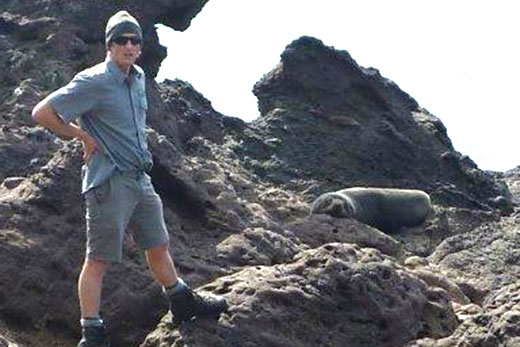The influx of New Zealand fur seals to Bay of Plenty beaches continues on, with up to 17 different seals reported at Bay beaches in the last week.
Seal sightings have been dubbed ‘the new normal' by the Department of Conservation, which reports seals are a natural part of Bay of Plenty ecosystems.
Service Ranger Dave Grimmer of the Tauranga District doing a routine check of a Seal around on the Mauao Rocks.
DOC ranger Dan Rapson says visitors and locals can expect to see seals enjoying local waters and Bay of Plenty beaches.
'Seals will naturally come ashore to rest.
'They prefer rocky outcrops but sometimes lie on sandy beaches or spend time in the shallows basking.
'In most cases there is nothing alarming going on. Seals' biggest threats are humans and dogs; so we want people to control their pets and to give seals space, as these animals are fully protected by law.”
Dan is grateful to the members of the public who ring the DOC Hotline about any injured seals.
'The vast majority of these seals are healthy and happy; but we want to know straight away if a seal is carrying a heavy injury, is tangled in netting, or is being harassed by dogs or people.”
Dan says New Zealand fur seals are still recovering from catastrophic reductions in population due to commercial hunting in the 19th century.
Numbers are expected to increase as new breeding colonies are established all over New Zealand, he says.
Breeding has been confirmed in the Bay of Plenty, with a small number of pups successfully weaned last season, from small rookeries on our offshore Islands.
How to watch seals safely
Always keep dogs on a leash and under your control when around seals
Always stay at least 20 metres away from seals.
Ensure you keep small children at a safe distance and under your control when watching seals.
Do not disturb seals. Don't make loud noises or throw things at them.
Do not feed seals. They don't need the food and won't eat it. It also encourages them to approach people which can put people and the seal at risk.
Do not get between a seal and the sea.
Risks posed by seals
Seals can and do bite. They have sharp teeth, and incredibly strong jaws which are three times as strong as an average dog.
They are surprisingly agile on land and can move very quickly if startled.
Never attempt to touch or handle a seal. They can be aggressive if threatened.
They also carry diseases that can be passed to humans and people have diseases that can make seals sick.
Normal seal behaviour
Most seals reported as injured or sick are simply resting.
Regurgitating, sneezing or coughing is normal behaviour for seals.
Seals can appear to be "crying". These are natural moisture secretions.
Young seals are often left alone on land for days while their mothers are at sea feeding. They do not need help so do not try to move them.
Seals often drift in the waves.
Seals often flap their flippers in the air to regulate their temperature. It's not a sign that they are stranded.
When to call DOC about a seal
Call DOC if a seal is severely injured, entangled in net or rope, in danger from dogs, vehicles or any other human activity. Take photos and record vehicle registration numbers if possible.
You can get DOC by calling 0800 DOCHOT - 0800 362 468



2 comments
vermin
Posted on 19-09-2014 16:05 | By petebennett@xtra.co.nz
I noticeable that folk these days are very senative to animals or mammals than they use to be. Can you tell me why, DOC,. or who ever are concerned about seals, they are now different than rats or opussums, they are the vermin of the sea.
Shark food
Posted on 20-09-2014 08:40 | By Bop man
More seals means more sharks as this is what they feed on.
Leave a Comment
You must be logged in to make a comment.